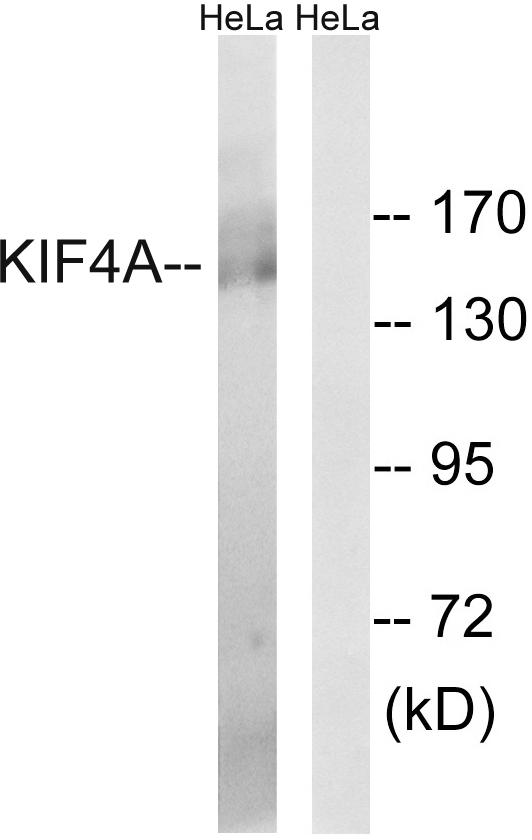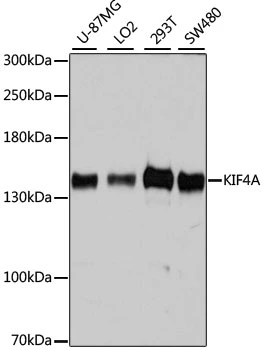KIF4A antibody [N1N2], N-term
GTX115759
ApplicationsImmunoFluorescence, Western Blot, ImmunoCytoChemistry, ImmunoHistoChemistry, ImmunoHistoChemistry Paraffin
Product group Antibodies
TargetKIF4A
Overview
- SupplierGeneTex
- Product NameKIF4A antibody [N1N2], N-term
- Delivery Days Customer9
- Application Supplier NoteWB: 1:500-1:3000. ICC/IF: 1:100-1:1000. IHC-P: 1:100-1:1000. *Optimal dilutions/concentrations should be determined by the researcher.Not tested in other applications.
- ApplicationsImmunoFluorescence, Western Blot, ImmunoCytoChemistry, ImmunoHistoChemistry, ImmunoHistoChemistry Paraffin
- CertificationResearch Use Only
- ClonalityPolyclonal
- Concentration1 mg/ml
- ConjugateUnconjugated
- Gene ID24137
- Target nameKIF4A
- Target descriptionkinesin family member 4A
- Target synonymsKIF4, KIF4G1, MRX100, TMDI, XLID100, chromosome-associated kinesin KIF4A, chromokinesin KIF4A, chromokinesin-A
- HostRabbit
- IsotypeIgG
- Protein IDO95239
- Protein NameChromosome-associated kinesin KIF4A
- Scientific DescriptionKinesins, such as KIF4A, are microtubule-based motor proteins that generate directional movement along microtubules. They are involved in many crucial cellular processes, including cell division (Zhu and Jiang, 2005 [PubMed 15625105]).[supplied by OMIM]
- Storage Instruction-20°C or -80°C,2°C to 8°C
- UNSPSC12352203
References
- Lin N, Chen L, Zhang Y, et al. KIF4A promotes tumor progression of bladder cancer via CXCL5 dependent myeloid-derived suppressor cells recruitment. Sci Rep. 2022,12(1):6015. doi: 10.1038/s41598-022-10029-xRead this paper
- Chase A, Pellagatti A, Singh S, et al. PRR14L mutations are associated with chromosome 22 acquired uniparental disomy, age-related clonal hematopoiesis and myeloid neoplasia. Leukemia. 2019,33(5):1184-1194. doi: 10.1038/s41375-018-0340-5Read this paper
- Zhang Y, Liu S, Qu D, et al. Kif4A mediate the accumulation and reeducation of THP-1 derived macrophages via regulation of CCL2-CCR2 expression in crosstalking with OSCC. Sci Rep. 2017,7(1):2226. doi: 10.1038/s41598-017-02261-7Read this paper
- Lin J, Wang K, Wang H, et al. Fucoidan reduced the invasion of oral squamous cell carcinoma cells and modified their effects to macrophages. Med Oncol. 2017,34(1):9. doi: 10.1007/s12032-016-0858-1Read this paper





